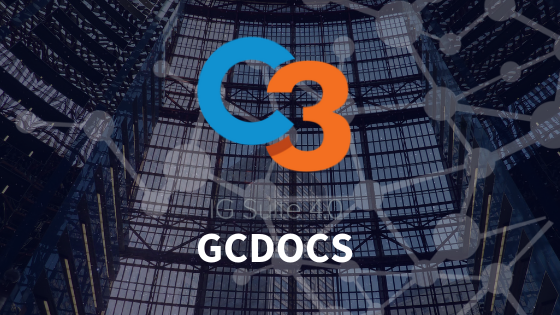Unlock GCDOCS’ Full Information Governance Capabilities
- Cogniva
- Oct 22, 2018
- 4 min read
Updated: Nov 2, 2018
Cogniva’s C3 Software is gaining significant traction in government departments by helping overcome user objections and by simplifying GCDOCS administration.
GCDOCS provides an ecosystem that combines technology and common information management (IM) elements in an effort to help achieve proper information governance. GCDOCS is based on the OpenText Content Server, which is recognized as an industry leading, proven enterprise content management (ECM) platform. ECM implementations are extremely complex projects and frequently encounter numerous obstacles. Many government departments are facing challenges in the implementation of GCDOCS including user adoption and the administration of folders, metadata, permissions and RSIs.
Cogniva’s C3 Software is gaining significant traction in government departments by helping overcome user objections and by simplifying GCDOCS administration in the following manner:
1. Enhances User Experience
With minimal user intervention, C3 substantially automates the creation of rich metadata. Based on the metadata values associated with a document, C3 will decide the appropriate metadata attributes, permissions and RSI. Furthermore, based on customized rules, C3 is able to route the document directly into the appropriate
GCDOCS folder.
2. Facilitates the governance and customization of the GCDOCS attributes pick lists
In GCDOCS, any changes to metadata attributes pick list values have to be submitted and managed manually. This is a lengthy process that has a significant impact on the user experience as users are often hindered, or delayed, from being able to save content.
With the C3 Governance module, users can request additions to attributes pick lists in real time using C3’s simple interface. Suggested changes are immediately posted to a decentralized governance dashboard for an approval or rejection decision to be made by the OPI of the subject matter – the person who really understands the context, implications and validity of the suggested change. Once the suggested change is approved the appropriate GCDOCS metadata attributes pick list is automatically updated. This ensures that the information architecture evolves with the organization in a timely yet controlled way and could eventually be usable across all other enterprise applications.
3. Solves the age-old "Enterprise Folder Structure Conundrum"
In GCDOCS, users are exposed to a complex folder structure. The complexity of the folder structure is not only driven by navigation needs, but also by the necessity of creating multiple additional folders and folder levels to explicitly show meaningful context and/or to support access and records management requirements. Advanced search filters exist in GCDOCS to provide a multi-facetted experience when searching for information. However, when it is time to capture and store information, organizations still predominately rely on folders, which are a single "facet" or dimension that all users must agree on.
C3 can help simplify the GCDOCS folder structures by automatically applying metadata, permissions and RSIs at the document level, which can be leveraged by GCDOCS via search, access, control and isposition protocols. In addition, C3 can be configured to enable content routing rules from MS Office or MS Explorer directly to GCDOCS folders.
4. Determines if content has business or enduring value using configurable rules
In GCDOCS, the final decision on what constitutes transitory information, information of business value or enduring value, is left with end users. This means that all users have to be trained on how to apply this complex set of rules in their day to day work. Experience has proven that users do a poor job at applying IM/Records Management (IM/RM) rules to content they generate and that continuous auditing and retraining is required to ensure the integrity of information.
With C3, compliance rules can be configured within the C3 meta-model. C3 is able to automatically apply rules based on the context in which the information is created or upon a semantic analysis of the content. This includes the accurate determination of business value or enduring value to the document in real time.
5. Makes GCDOCS "aware" of sensitive or protected content
C3’s text analytics engine can identify sensitive information or information containing personal data and set an attribute in GCDOCS to make it aware that the information is sensitive in nature. C3 can also mark MS Office or PDF documents with a header, footer or watermark indicating that a particular document contains sensitive information.
6. Applies the correct metadata values to guarantee consistent and complete search results
Because it is risky to rely on users to consistently and accurately describe and organize content, search results are inevitably affected. ECM systems often rely of free text metadata which create major challenges with respect to search and e-discovery.
This is further compounded by IM practitioners having little faith in the up-front tagging of documents, leading to significant obstacles when attempting to apply automated retention and disposition policies.
C3 leverages predetermined taxonomies and uses semantic relationships and autoclassification thereby filtering the metadata values to the business context of the document. The use of controlled vocabularies means that all information will be tagged, organized and classified in a consistent and coherent way. C3’s thesaurus feature allows for the natural language variances to be considered during search and autoclassification, despite the use of standardized terminology when tagging the document.
C3 is the only multi-facetted, patented technology that works alongside GCDOCS to semantically relate an organization’s concepts to help it reach sustainable information governance.
7. Provides a tool-agnostic domain to maintain the Information Architecture and IM/RM rules
The information architecture (metadata Framework, IM/RM rules) required by GCDOCS is maintained and locked within GCDOCS and the same holds true for other systems and platforms. This makes content integration between and across applications, systems and platforms difficult. With C3, the information architecture is tool-agnostic and can be leveraged by a large number of systems and platforms.
In summary
The seamless addition of C3 Software into the GCDOCS environment will help resolve the current implementation challenges and ultimately unlock its full information governance capabilities.
Yves Marleau,
President and CEO









Comments